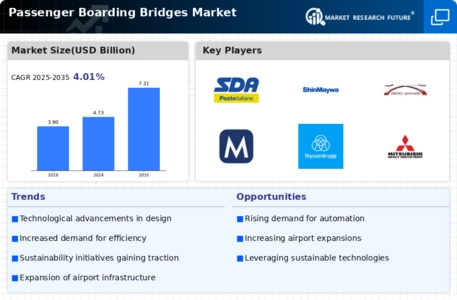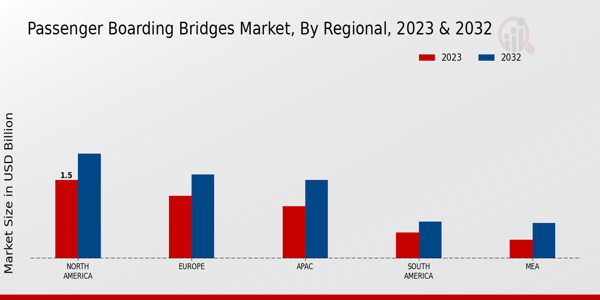Market Analysis
Passenger Boarding Bridges Market (Global, 2023)
Introduction
The Passenger Boarding Bridges Market is a critical component of the aviation infrastructure, facilitating the seamless transition of passengers between the terminal and aircraft. As air travel continues to evolve, the demand for efficient and technologically advanced boarding solutions has become increasingly pronounced. Factors such as the expansion of airports, the rise in air traffic, and the growing emphasis on passenger comfort and safety are driving innovations in boarding bridge design and functionality. Additionally, the integration of smart technologies and automation in boarding processes is reshaping the landscape, offering enhanced operational efficiency and improved passenger experiences. This market analysis delves into the current trends, challenges, and opportunities within the Passenger Boarding Bridges Market, providing a comprehensive overview of the dynamics that are shaping its future.
PESTLE Analysis
- Political
- In 2023, government policies regarding airport infrastructure development have a direct impact on the Passenger Boarding Bridges market. For instance, the Federal Aviation Administration (FAA) in the United States allocated $3.2 billion for airport improvement projects, which includes the modernization of boarding bridges. Additionally, international regulations from the International Civil Aviation Organization (ICAO) emphasize the need for enhanced passenger safety and accessibility, influencing airports worldwide to upgrade their facilities, including boarding bridges.
- Economic
- The global economic landscape in 2023 has seen a rise in air travel demand, with the International Air Transport Association (IATA) reporting that global passenger numbers reached approximately 4.5 billion. This surge in air traffic has prompted airports to invest heavily in infrastructure, with an estimated $10 billion earmarked for airport upgrades, including the installation of new passenger boarding bridges. Furthermore, the increasing competition among airlines has led to a focus on improving passenger experience, further driving the demand for advanced boarding solutions.
- Social
- Social trends in 2023 indicate a growing emphasis on passenger comfort and convenience during air travel. Surveys show that 78% of travelers prioritize seamless boarding experiences, which has led airports to adopt more sophisticated boarding bridge technologies. Additionally, the rise of eco-conscious travelers has prompted airports to consider sustainable options, with 65% of passengers expressing a preference for facilities that utilize energy-efficient systems in their boarding processes.
- Technological
- Technological advancements are reshaping the Passenger Boarding Bridges market in 2023. Innovations such as automated boarding bridges and smart technology integration are becoming standard, with 40% of new installations featuring advanced automation systems. Moreover, the implementation of IoT (Internet of Things) in boarding bridges allows for real-time monitoring and maintenance, reducing downtime and enhancing operational efficiency. This technological shift is supported by a projected investment of $1.5 billion in smart airport technologies across the globe.
- Legal
- In 2023, legal frameworks governing airport operations and safety standards are becoming increasingly stringent. The European Union has introduced new regulations mandating that all airports comply with enhanced safety protocols, which include the regular inspection and maintenance of passenger boarding bridges. Compliance with these regulations is estimated to cost airports an average of $250,000 annually per bridge, emphasizing the importance of legal adherence in the operational budget of airport authorities.
- Environmental
- Environmental considerations are becoming a priority in the Passenger Boarding Bridges market in 2023. Airports are under pressure to reduce their carbon footprint, with a target set by the United Nations to achieve net-zero emissions by 2050. As part of this initiative, many airports are investing in eco-friendly boarding bridges that utilize sustainable materials and energy-efficient technologies. It is estimated that the adoption of green technologies in boarding bridges could reduce energy consumption by up to 30%, aligning with global sustainability goals.
Porter's Five Forces
- Threat of New Entrants
- Medium - The Passenger Boarding Bridges Market has moderate barriers to entry due to the need for significant capital investment and technical expertise. Established players benefit from brand recognition and customer loyalty, which can deter new entrants. However, advancements in technology and increasing demand for airport infrastructure may attract new competitors.
- Bargaining Power of Suppliers
- Low - The bargaining power of suppliers in the Passenger Boarding Bridges Market is relatively low. There are multiple suppliers for the raw materials and components required to manufacture boarding bridges, which reduces the influence any single supplier can exert. Additionally, manufacturers can switch suppliers without significant cost implications.
- Bargaining Power of Buyers
- High - Buyers in the Passenger Boarding Bridges Market, primarily airports and airlines, hold significant bargaining power. They often have the ability to negotiate prices and demand customized solutions due to the limited number of large-scale buyers. This power is further amplified by the availability of alternative suppliers and the critical nature of the product for airport operations.
- Threat of Substitutes
- Medium - The threat of substitutes in the Passenger Boarding Bridges Market is moderate. While there are alternative methods for boarding passengers, such as buses or stairs, these options are generally less efficient and less preferred by airlines and passengers. However, innovations in airport design and passenger flow management could introduce new alternatives over time.
- Competitive Rivalry
- High - Competitive rivalry in the Passenger Boarding Bridges Market is high, with several established players vying for market share. Companies compete on factors such as price, quality, and technological advancements. The market is characterized by frequent product innovations and improvements, leading to intense competition among manufacturers.
SWOT Analysis
Strengths
- High demand for efficient airport operations and passenger convenience.
- Technological advancements leading to improved safety and reliability.
- Strong growth in the aviation industry post-pandemic, increasing airport infrastructure investments.
Weaknesses
- High initial investment costs for installation and maintenance.
- Dependence on airport traffic volumes, which can be volatile.
- Limited market players leading to potential monopolistic practices.
Opportunities
- Expansion of airports in emerging markets creating new demand.
- Integration of smart technologies and automation in boarding processes.
- Sustainability trends driving demand for eco-friendly boarding solutions.
Threats
- Economic downturns affecting airline operations and airport funding.
- Competition from alternative boarding solutions like mobile boarding.
- Regulatory changes impacting manufacturing and operational standards.
Summary
The Passenger Boarding Bridges Market in 2023 is characterized by strong demand driven by the recovery of the aviation sector and technological advancements. However, the market faces challenges such as high costs and dependence on fluctuating airport traffic. Opportunities for growth exist in emerging markets and through the adoption of smart technologies, while threats from economic instability and regulatory changes could impact future developments. Strategic focus on innovation and sustainability will be crucial for market players to navigate these dynamics.














Leave a Comment